All children deserve a quality education. Together, we can help them reach their dreams.
Learn more about Teach for Life, the educational branch of Trees for Life.

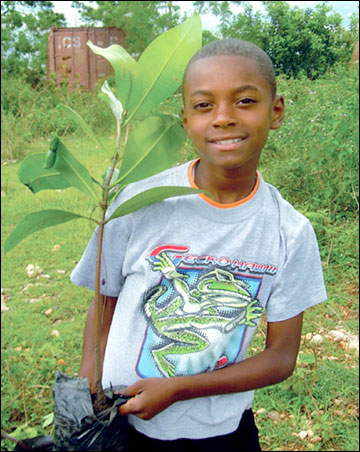
Sometimes a traveler lost in darkness will see the flicker of a candle in the distance and find the path. This is one such story-of hope rekindled in the midst of deep despair.
Having spent my first 40 years in the USA, I know Haiti's ecological disaster is impossible to imagine. I can only share some telling facts: More than 400,000 tons of wood are cut yearly for firewood in Haiti. Only 1% of the trees remain. More than 400 rivers and streams have dried up. Only five water tables out of thirty remain, and the aquifer is threatened. Millions of tons of topsoil and trash have killed the coral reefs. Fishermen must now go miles from shore to find fish. Jacques Cousteau called Haiti's environmental crisis a "slow genocide."
Millions of dollars have been given by USAID and other foreign organizations. As most people here know, a few people end up with large homes and new SUVs, while very little happens for the common people. So, people don?t trust the government or local organizations.
These conditions accelerated when, in 2004, the government collapsed. At about the same time, the small cyber café I owned with my friends failed. As I witnessed the destruction of the country, my heart broke and I shed many tears.
But then I reminded myself why I came to Haiti in the first place. My mission was regeneration, renewal, and the celebration of life under the direst of circumstances. My task, then, was to not get discouraged.
So I sold my car and used the money to start a tree nursery in my backyard. To conserve resources, my assistant and I saved seeds from the fruits we ate. In a short time, we were thrilled to see more than 10,000 fruit and forest tree seedlings cover our backyard.
There was another reason for our joy: Fritz Desulme. Since 1987, he had helped plant an estimated 250,000 trees with practically no support. He came from a poor family, but lack of money never stopped him and his volunteers. He was my inspiration.
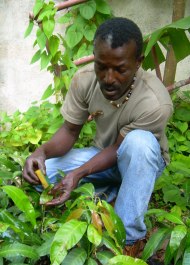 I met Fritz in 1989, and my small church group funded his planting of seedlings from the Ministry of Agriculture. When the government collapsed, he could no longer get those seedlings. But now, with the saplings in our nursery, Fritz could continue his work.
I met Fritz in 1989, and my small church group funded his planting of seedlings from the Ministry of Agriculture. When the government collapsed, he could no longer get those seedlings. But now, with the saplings in our nursery, Fritz could continue his work.
One day a group of some 65 local students contacted me. They wanted to do something for the environment. Claire Pressoir was the leader, and she and I bonded. Claire and I struggled with what to call our "movement" I saw tree cutting as a slow death, and tree planting as bringing new life. We needed a simple message to inspire people. So I decided the perfect name would be "Trees for Life."
While preparing for our first workshop, I came across a quote by a man named Balbir Mathur: "Trees for Life is really not about planting trees, but about the regeneration of the spirit of people.? I read the quote to Claire, and a deep silence fell between us. Then Claire spoke: ?We must contact this organization now." We checked their website, and soon I was in touch with Balbir and Treva in Wichita, Kansas.
We were impressed with the Trees for Life philosophy: people have to take responsibility and not be victims waiting for others to help them. This was so true for Haiti. We asked permission to use this philosophy. They said, "The philosophy of Trees for Life does not belong to us, but to the universe. All our information is copyright-free and available to everyone." They assured us of their financial support as well.
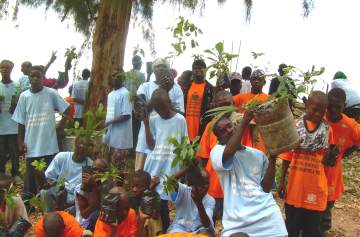
Massive benefits come when people come together to serve their communities. These homeless boys helped plant 9,000 trees on a mountainside - one of many activities organized to steer them away from violent gangs. Their t-shirts say in Creole "Take care of the Earth, the Earth will take care of you."
We proudly named ourselves "Trees for Life, Haiti." We now had a candle to guide us through the dark night. One of our most exciting projects was planting trees on Boutillier Mountain and Mon’lopital with 120 homeless boys. We provided 7,000 saplings, and the boys' group contributed 2,000 saplings. Fifty additional volunteers from all backgrounds and ages joined us. A local band performed, and there was food and drinks. For two days we planted-even during the rain. I have never seen so many boys and men hug each other; their smiles and laughter were priceless. They knew they were doing something important for their future.
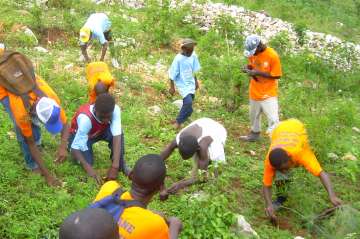

Our next project was in Mapou. Three years ago, a hurricane took the lives and homes of 8,000 people there. For two years they had asked the government to help them plant trees to stop erosion, but to no effect. We shared the Trees for Life philosophy: They could not wait for the government; they had to take responsibility. When they realized we were truly there to help the community, they came together and planted 5,900 saplings with help from Trees for Life and the French Red Cross. Many people expressed deep gratitude.
In a community called Bongau, some 150 people joined hands and asked us for trees and organizational guidance. We helped them plant 3,500 trees, and assisted them in starting a nursery of 30,000 more trees.
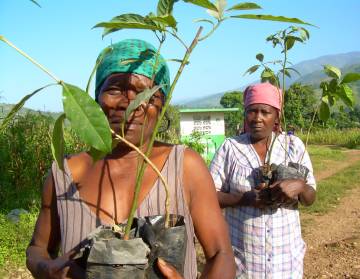
We are maintaining our nursery, working with students and inspiring other groups to plant trees in their own communities. It may not seem like much, but each step is a major victory and a cause for celebration.

Many of the students have now graduated, and Claire will soon be working for a development program. I am sure the experience has left them all with a renewed attitude about what is possible when the focus is on "Life." I am sure of it, because it has done the same for me.